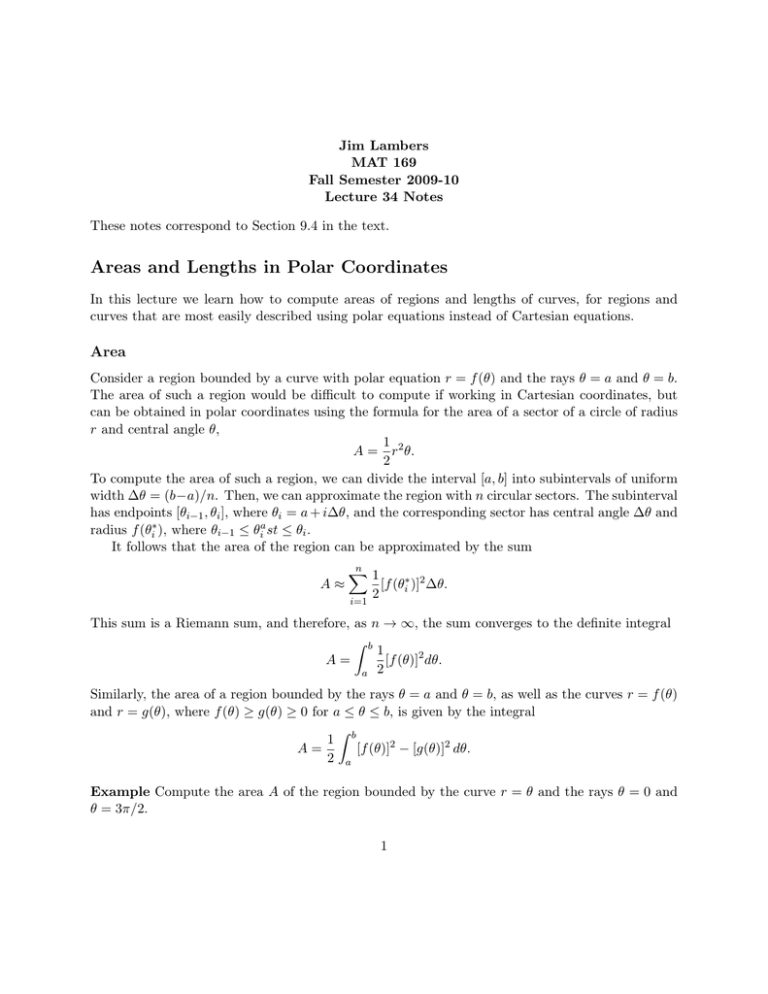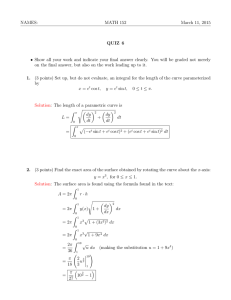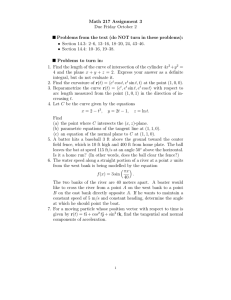Areas and Lengths in Polar Coordinates
advertisement

Jim Lambers MAT 169 Fall Semester 2009-10 Lecture 34 Notes These notes correspond to Section 9.4 in the text. Areas and Lengths in Polar Coordinates In this lecture we learn how to compute areas of regions and lengths of curves, for regions and curves that are most easily described using polar equations instead of Cartesian equations. Area Consider a region bounded by a curve with polar equation 𝑟 = 𝑓 (𝜃) and the rays 𝜃 = 𝑎 and 𝜃 = 𝑏. The area of such a region would be difficult to compute if working in Cartesian coordinates, but can be obtained in polar coordinates using the formula for the area of a sector of a circle of radius 𝑟 and central angle 𝜃, 1 𝐴 = 𝑟2 𝜃. 2 To compute the area of such a region, we can divide the interval [𝑎, 𝑏] into subintervals of uniform width Δ𝜃 = (𝑏−𝑎)/𝑛. Then, we can approximate the region with 𝑛 circular sectors. The subinterval has endpoints [𝜃𝑖−1 , 𝜃𝑖 ], where 𝜃𝑖 = 𝑎 + 𝑖Δ𝜃, and the corresponding sector has central angle Δ𝜃 and radius 𝑓 (𝜃𝑖∗ ), where 𝜃𝑖−1 ≤ 𝜃𝑖𝑎 𝑠𝑡 ≤ 𝜃𝑖 . It follows that the area of the region can be approximated by the sum 𝐴≈ 𝑛 ∑ 1 𝑖=1 2 [𝑓 (𝜃𝑖∗ )]2 Δ𝜃. This sum is a Riemann sum, and therefore, as 𝑛 → ∞, the sum converges to the definite integral ∫ 𝑏 1 𝐴= [𝑓 (𝜃)]2 𝑑𝜃. 𝑎 2 Similarly, the area of a region bounded by the rays 𝜃 = 𝑎 and 𝜃 = 𝑏, as well as the curves 𝑟 = 𝑓 (𝜃) and 𝑟 = 𝑔(𝜃), where 𝑓 (𝜃) ≥ 𝑔(𝜃) ≥ 0 for 𝑎 ≤ 𝜃 ≤ 𝑏, is given by the integral ∫ 1 𝑏 𝐴= [𝑓 (𝜃)]2 − [𝑔(𝜃)]2 𝑑𝜃. 2 𝑎 Example Compute the area 𝐴 of the region bounded by the curve 𝑟 = 𝜃 and the rays 𝜃 = 0 and 𝜃 = 3𝜋/2. 1 Solution We have 𝐴 = = = = 1 2 ∫ 3𝜋/2 𝜃2 𝑑𝜃 0 3𝜋/2 𝜃3 1 2 3 0 27𝜋 3 48 9𝜋 3 . 16 The curve is illustrated in Figure 1. □ Figure 1: Curve 𝑟 = 𝜃, 0 ≤ 𝜃 ≤ 3𝜋/2 Example Compute the area 𝐴 of the region bounded by the curve 𝑟 = 𝜃 = 0 and 𝜃 = 𝜋/4. 2 √ sin 𝜃 cos 𝜃 and the rays Solution We have 𝐴 = = 1 2 ∫ 1 2 ∫ 𝜋/4 √ ( sin 𝜃 cos 𝜃)2 𝑑𝜃 0 𝜋/4 sin 𝜃 cos 𝜃 𝑑𝜃 0 ∫ 𝜋/4 sin 2𝜃 𝑑𝜃 2 0 − cos 2𝜃 𝜋/4 8 1 2 = = 0 1 [− cos 2(𝜋/4) − (− cos 2(0))] 8 1 [− cos 𝜋/2 + cos 0] 8 1 . 8 = = = The curve is illustrated in Figure 2. □ Arc Length Recall that the arc length of a curve represented by parametric equations 𝑥 = 𝑓 (𝜃), 𝑦 = 𝑔(𝜃) is given by ∫ 𝐿= 𝑎 𝑏 √( 𝑑𝑥 𝑑𝜃 )2 ( + 𝑑𝑦 𝑑𝜃 )2 𝑑𝜃, where 𝜃 is the parameter, and the curve is defined for 𝑎 ≤ 𝜃 ≤ 𝑏. Ideally we would like to be able to compute the arc length of a curve directly from its polar equation, instead of always having to convert to Cartesian coordinates. Since Cartesian coordinates and polar coordinates are related by the equations 𝑥 = 𝑟 cos 𝜃, 𝑦 = 𝑟 sin 𝜃, it follows from the Product Rule that 𝑑𝑥 𝑑𝑟 = cos 𝜃 − 𝑟 sin 𝜃, 𝑑𝜃 𝑑𝜃 We then have ( 𝑑𝑥 𝑑𝜃 )2 ( + 𝑑𝑦 𝑑𝜃 )2 ( = 𝑑𝑦 𝑑𝑟 = sin 𝜃 + 𝑟 cos 𝜃. 𝑑𝜃 𝑑𝜃 𝑑𝑟 cos 𝜃 − 𝑟 sin 𝜃 𝑑𝜃 3 )2 ( + 𝑑𝑟 sin 𝜃 + 𝑟 cos 𝜃 𝑑𝜃 )2 Figure 2: Curve 𝑟 = ( 𝑑𝑟 𝑑𝜃 ( 𝑑𝑟 𝑑𝜃 = )2 )2 √ sin 𝜃 cos 𝜃, 0 ≤ 𝜃 ≤ 𝜋/4 cos2 𝜃 − 2𝑟 𝑑𝑟 sin 𝜃 cos 𝜃 + 𝑟2 sin2 𝜃 + 𝑑𝜃 𝑑𝑟 sin 𝜃 cos 𝜃 + 𝑟2 cos2 𝜃 𝑑𝜃 ( )2 ( )2 𝑑𝑟 𝑑𝑟 2 = cos 𝜃 + sin2 𝜃 + 𝑟2 sin2 𝜃 + 𝑟2 cos2 𝜃 𝑑𝜃 𝑑𝜃 ( )2 𝑑𝑟 = + 𝑟2 . 𝑑𝜃 sin2 𝜃 + 2𝑟 It follows that the arc length of a curve can be obtained directly from its polar equation, using the formula √ ( )2 ∫ 𝑏 𝑑𝑟 2 𝐿= 𝑟 + 𝑑𝜃. 𝑑𝜃 𝑎 Example Compute the arc length 𝐿 of the curve 𝑟 = cos 𝜃, where 0 ≤ 𝜃 ≤ 𝜋/2. 4 Solution We have 𝑑𝑟/𝑑𝜃 = − sin 𝜃, and therefore √ ( )2 ∫ 𝜋/2 𝑑𝑟 2 𝐿 = 𝑑𝜃 𝑟 + 𝑑𝜃 0 ∫ 𝜋/2 √ = cos2 𝜃 + (− sin 𝜃)2 𝑑𝜃 0 ∫ = 𝜋/2 √ cos2 𝜃 + sin2 𝜃 𝑑𝜃 0 ∫ 𝜋/2 1 𝑑𝜃 = 0 = 𝜋 . 2 The curve is illustrated in Figure 3. □ Figure 3: Curve 𝑟 = cos 𝜃, 0 ≤ 𝜃 ≤ 𝜋/2 5 Summary ∙ The area of the region bounded by the polar curve 𝑟 = 𝑓 (𝜃), the ray 𝜃 = 𝑎, and the ray 𝜃 = 𝑏 is half of the integral of 𝑟2 from 𝑎 to 𝑏. √ ∙ The arc length of a polar curve 𝑟 = 𝑓 (𝜃), where 𝑎 ≤ 𝜃 ≤ 𝑏, is the integral of 𝑟2 + (𝑑𝑟/𝑑𝜃)2 from 𝑎 to 𝑏. 6




